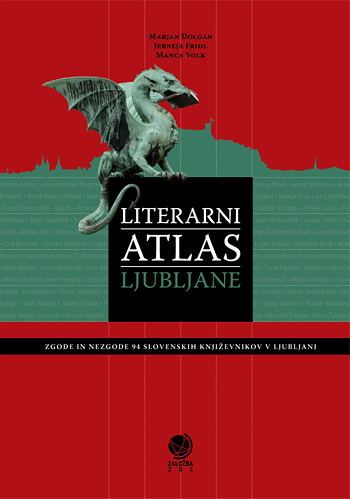Literary atlas of Ljubljana
Marjan Dolgan, Jerneja Fridl, Manca Volk Bahun, ZRC SAZU
July, 2014
Summary
The capitals of foreign countries boast different publications, through which visitors can learn about various aspects of the city's history. These include literary atlases, in which tourists can look for places that are associated with the life and work of famous writers. Ljubljana lacked such an atlas, so the Institute of Slovenian Literature and Literary Studies in cooperation with Anton Melik Geographical Institute prepared Literary Atlas of Ljubljana, which is the first of its kind in Slovenia.
The introduction includes information about the selection of writers, the composition of Atlas and its use. The second part comprises biographical entries about 94 Slovenian writers who lived and worked in Ljubljana. Biographies present their residences; schools; cultural institutions, which are related to their major works (libraries, theaters, publishing houses); cafes and restaurants they frequented; places, where they have experienced different forms of repression; hospitals in which they were treated or where they died; cemeteries, where they are (were) buried; and memorials and names, with which Ljubljana honored them. The Atlas discusses deceased and important writers, but it also considers those who have not been canonized and such whose works are not top quality, but they were influential or, because of their eccentric way of life, remarkable.
Articles avoid narrating the entire development of writers or their oeuvres, as such descriptions are already contained in literary history. The Atlas rather focuses on biographical-spatial aspects of their lives and works that are connected with the Slovene capital. In the case of major writers, the final parts of articles offer selections of their most important texts on Ljubljana; the awards they got; their memorials and street names; and bibliography of sources.
Most writers who have worked and created in Ljubljana, were born outside the city and came here to study. Many have returned to it after their graduation at foreign universities. These facts in many cases influenced their stay in Ljubljana, what is also taken into account in respective entries. Some writers spent last years of life in other places and only occasionally returned to Ljubljana. Others still did not want to be buried here. In such a case, the Atlas also considers locations other than Ljubljana. Other locations are a supplement of which becomes even more evident that Ljubljana represented literary, cultural and political capital of Slovenian ethnic territory.
The third part of the Atlas includes thematic maps, which are organized according to periods of literary history. Biographical entries and maps are linked with a special system of numerical and alphabetical codes.
Literary Atlas of Ljubljana is intended not only for professional researchers of literature, but also for those readers who are interested in biographical-historical details and spatial background of important writers during their stay in Ljubljana. Literary Atlas of Ljubljana is the first example of interdisciplinary cooperation between literary history and geography in Slovenia. Marjan Dolgan wrote the literary-historical part of the Atlas, while Jerneja Fridl in collaboration with Manca Volk Bahun authored the cartography. The research project Space of Slovenian literary culture focuses on the historical period between 1780 and 1940. The time span of Literary Atlas of Ljubljana is broader, from the Middle Ages to the present. The present webpages include only writers from the period 1780–1940. The entire Atlas is available in a book form.
(Translated and adapted by Marko Juvan)

